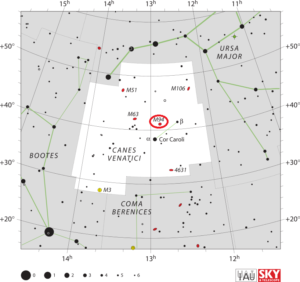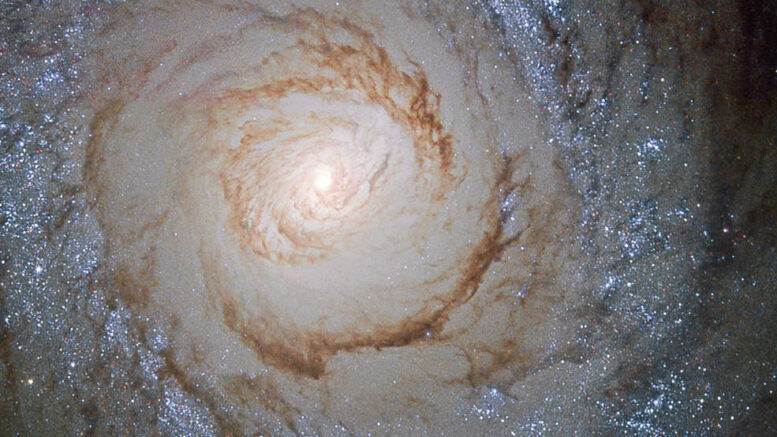Messier 94, also known as Cats Eye Galaxy or the Crocs Eye Galaxy, is a spiral galaxy located in the constellation Canes Venatici. Messier 94 is the central galaxy in the M94 Group, also known as the Canes Venatici I Cloud (CVn I Cloud), a group that contains 16 to 24 galaxies.
Messier 94 is classified as a LINER galaxy, or a galaxy with a low ionization nuclear emission region (LINER). This means that the nucleus of M94 contains ionized gas, but that the gas is only weakly ionized.
| Description | |
| Visible From Pacific Northwest | December to May |
| Best Time To Observe | April |
| Minimum Size Of Viewing Device | Small Telescope |
| Object Type | Spiral Galaxy |
| Designations | Messier 94, M94, NGC 4736, Cat’s Eye Galaxy, Croc’s Eye Galaxy, PGC 43495, UGC 7996, BWE 1248+4123, IRAS 12485+4123, 2MASX J12505314+4107125, MCG+07-26-058, RBS 1168, RGB J1250.9+4107, RX J1250.8+4107, UZC J125053.0+410715, WB 1248+4123, Z 217-1, Z 216-34, Z 1248.5+4123, NVSS J125053+410708 |
| Right Ascension | 12h 50m 53.1s |
| Declination | +41°07’14’’ |
| Constellation | Canes Venatici |
| Number Of Stars | 40,000,000,000 (40 billion) |
| Apparent magnitude | +8.99 |
| Apparent dimensions | 11’.2 x 9’.1 |
| Object Radius | 25,000 light years |
| Distance From Earth | 16,000,000 light years |
History
Messier 94 was discovered by Charles Messier’s colleague Pierre Méchain on March 2, 1781. Méchain reported the discovery to Messier, who found the object, determined its position, and added it to his catalogue of comet-like objects on March 24, 1781.
William Herschel observed the object on March 18, 1787 and described it as “very brilliant” noting “a large, luminous nucleus of more than 20″ diameter with faint chevalure and branches extending 6 or 8′.”
John Herschel catalogued M94 as h 1456 and later added it to the General Catalogue as GC 3258. He described the object as “very bright; large; irregularly round; very suddenly very much brighter toward the middle where there is a bright nucleus; mottled.”
Locating M94 In The Sky
Messier 94 can be found 3 degrees east and a little south of Chara, the second brightest star in Canes Venatici. Chara lies a little more than 5 degrees northwest of Cor Caroli, the constellation’s brightest star. Cor Caroli can be found under Alkaid, the star that marks the tip of the handle of the Big Dipper asterism in Ursa Major. The best time of year to observe M94 is during the spring.

Viewing M94
The galaxy can be spotted with binoculars under exceptionally good conditions, but only appears as a small, dim patch of light. Even small telescopes will reveal the object as a galaxy. Smaller instruments show M94 as a fuzzy patch with a brighter centre, while 6-inch and 8-inch telescopes reveal a bright, condensed nucleus surrounded by a nebulosity that hints at spiral structure. Larger amateur telescopes reveal a bright ring around the galaxy’s nucleus and other details of M94’s structure.
Photographing M94
Imaging the Cats Eye Galaxy, Messier 94, requires time and a large telescope to fully realize the beauty. Automated guidance and a CMOS camera will help provide the best image possible. Using filters will be crucial to bring out the color of the galaxy. Smaller telescopes can definitely work to provide general photos of the entire galaxy, but larger scopes will be able to provide more detail.
https://www.cloudynights.com/topic/540164-messier-94/
https://www.astrobin.com/346559/?nc=user
Sources And Further Reading
Descriptions of all of Messier Objects can be found here.
https://www.nasa.gov/feature/goddard/2017/messier-94
http://www.messier.seds.org/m/m094.html

Be the first to comment on "Messier 94 Cats Eye Galaxy"